High School Presentation: Aging Changes, STDs, and Prevention
VerifiedAdded on 2022/08/26
|17
|1232
|13
Presentation
AI Summary
This presentation, designed for high school students, addresses normative aging changes, particularly focusing on puberty and its physiological and psychological impacts. It delves into various sexually transmitted diseases (STDs), including gonorrhea, chlamydia, herpes, HIV/AIDS, syphilis, and HPV, detailing their causes, symptoms, complications, and treatment options. The presentation also covers pregnancy and prevention strategies, emphasizing the importance of education and awareness. The content is supported by scholarly sources and adheres to the assignment brief's requirements, providing a comprehensive overview of adolescent health and well-being.
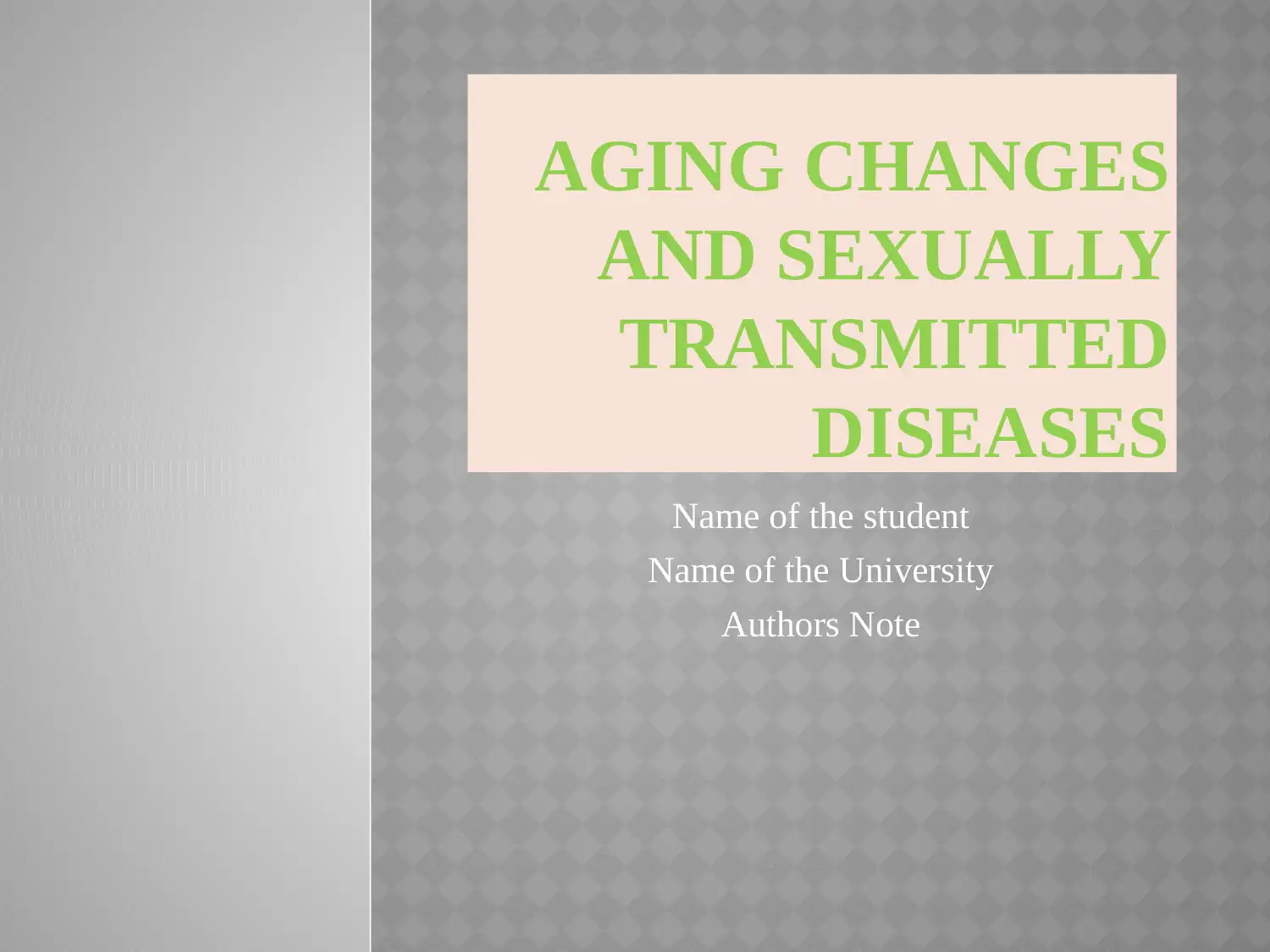
AGING CHANGES
AND SEXUALLY
TRANSMITTED
DISEASES
Name of the student
Name of the University
Authors Note
AND SEXUALLY
TRANSMITTED
DISEASES
Name of the student
Name of the University
Authors Note
Paraphrase This Document
Need a fresh take? Get an instant paraphrase of this document with our AI Paraphraser
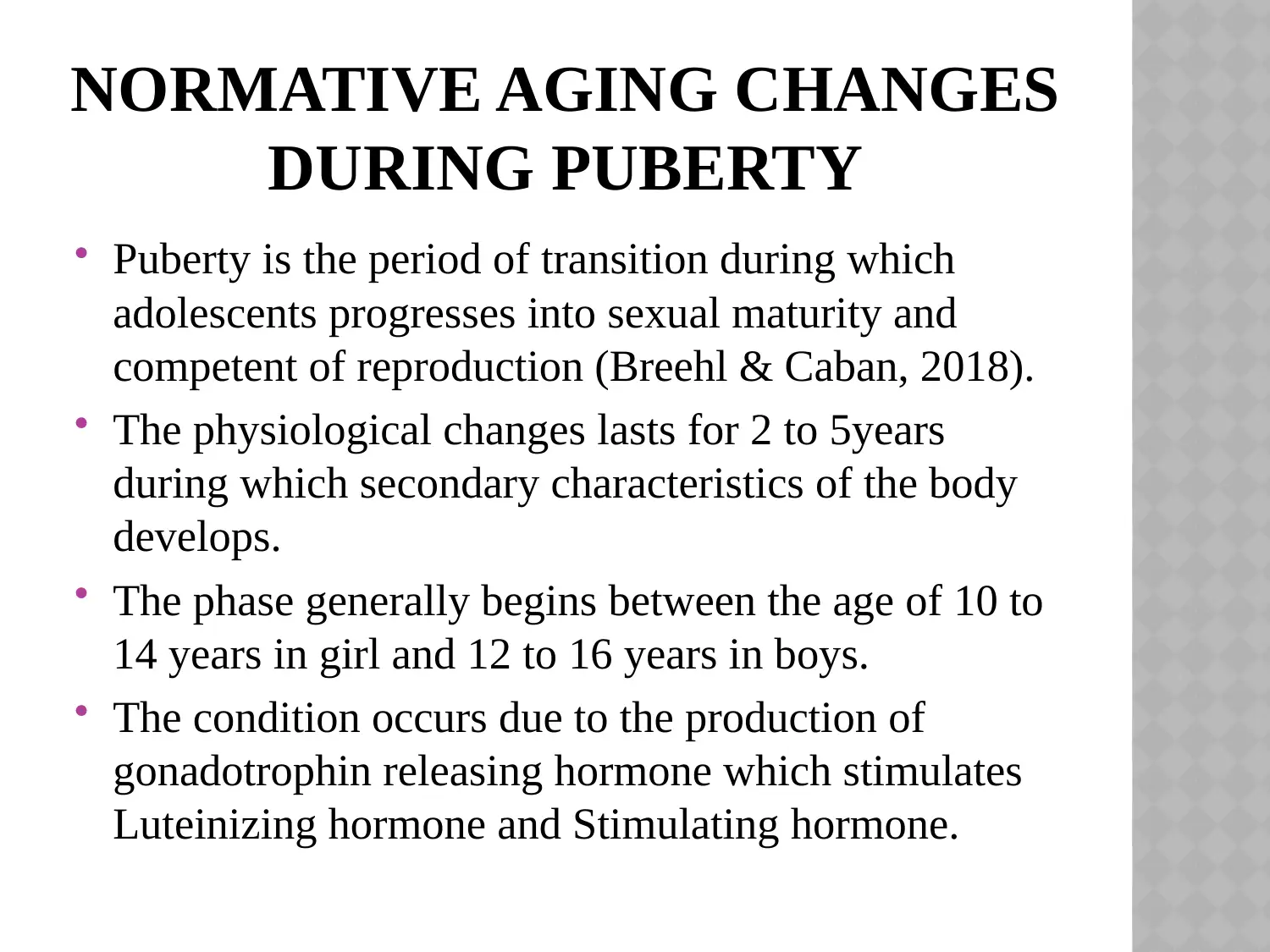
NORMATIVE AGING CHANGES
DURING PUBERTY
Puberty is the period of transition during which
adolescents progresses into sexual maturity and
competent of reproduction (Breehl & Caban, 2018).
The physiological changes lasts for 2 to 5years
during which secondary characteristics of the body
develops.
The phase generally begins between the age of 10 to
14 years in girl and 12 to 16 years in boys.
The condition occurs due to the production of
gonadotrophin releasing hormone which stimulates
Luteinizing hormone and Stimulating hormone.
DURING PUBERTY
Puberty is the period of transition during which
adolescents progresses into sexual maturity and
competent of reproduction (Breehl & Caban, 2018).
The physiological changes lasts for 2 to 5years
during which secondary characteristics of the body
develops.
The phase generally begins between the age of 10 to
14 years in girl and 12 to 16 years in boys.
The condition occurs due to the production of
gonadotrophin releasing hormone which stimulates
Luteinizing hormone and Stimulating hormone.
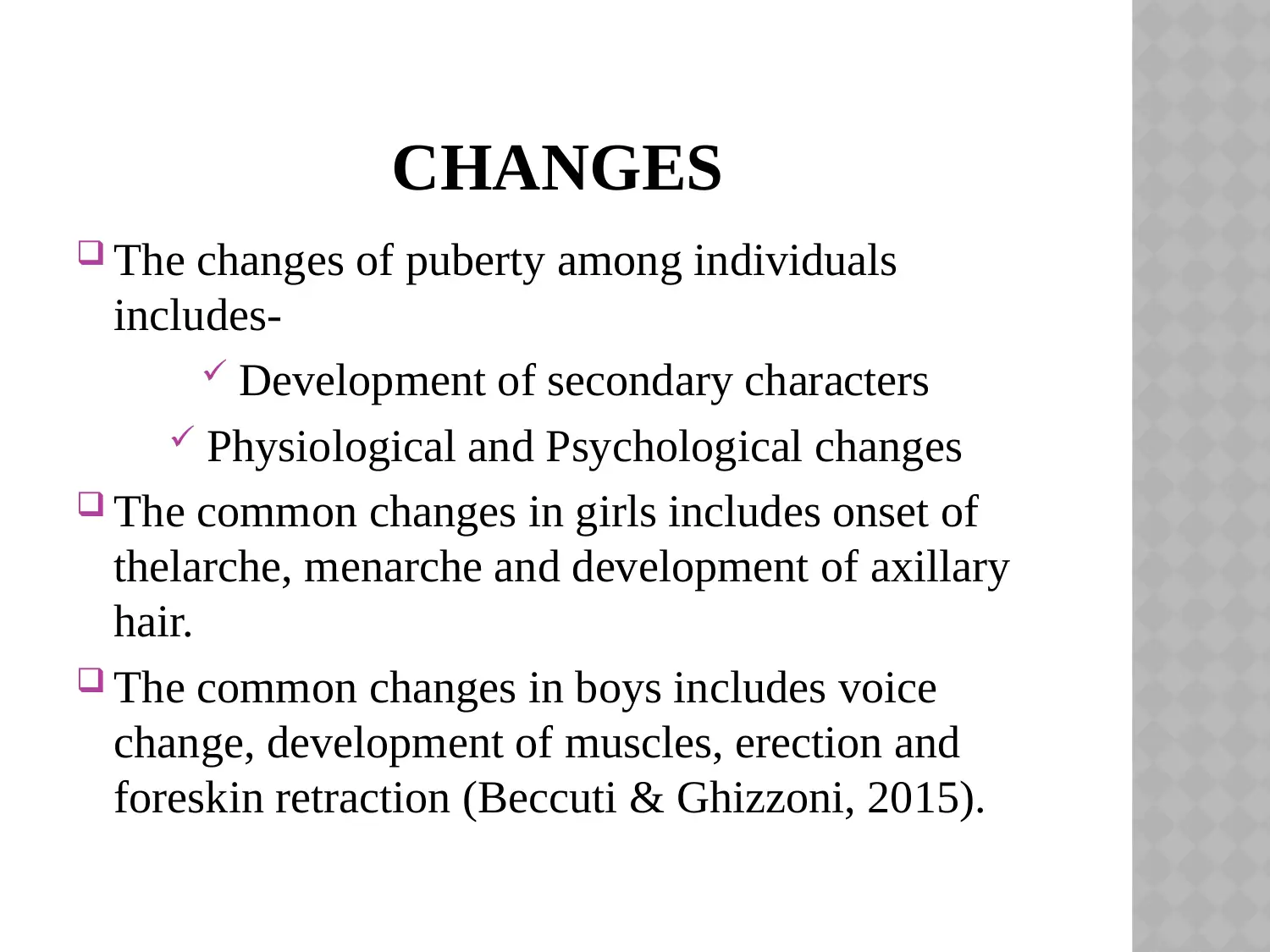
CHANGES
The changes of puberty among individuals
includes-
Development of secondary characters
Physiological and Psychological changes
The common changes in girls includes onset of
thelarche, menarche and development of axillary
hair.
The common changes in boys includes voice
change, development of muscles, erection and
foreskin retraction (Beccuti & Ghizzoni, 2015).
The changes of puberty among individuals
includes-
Development of secondary characters
Physiological and Psychological changes
The common changes in girls includes onset of
thelarche, menarche and development of axillary
hair.
The common changes in boys includes voice
change, development of muscles, erection and
foreskin retraction (Beccuti & Ghizzoni, 2015).
⊘ This is a preview!⊘
Do you want full access?
Subscribe today to unlock all pages.

Trusted by 1+ million students worldwide
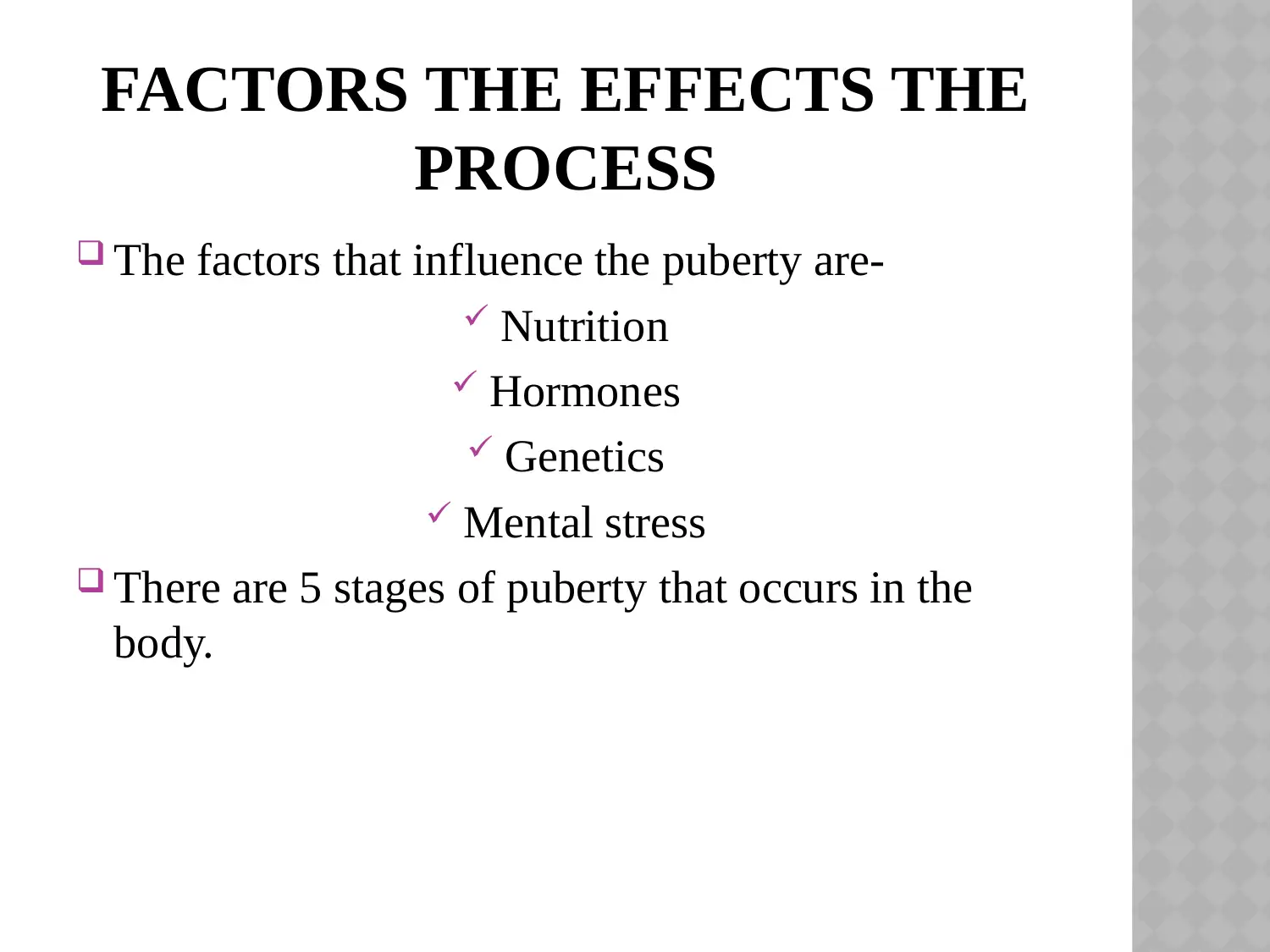
FACTORS THE EFFECTS THE
PROCESS
The factors that influence the puberty are-
Nutrition
Hormones
Genetics
Mental stress
There are 5 stages of puberty that occurs in the
body.
PROCESS
The factors that influence the puberty are-
Nutrition
Hormones
Genetics
Mental stress
There are 5 stages of puberty that occurs in the
body.
Paraphrase This Document
Need a fresh take? Get an instant paraphrase of this document with our AI Paraphraser
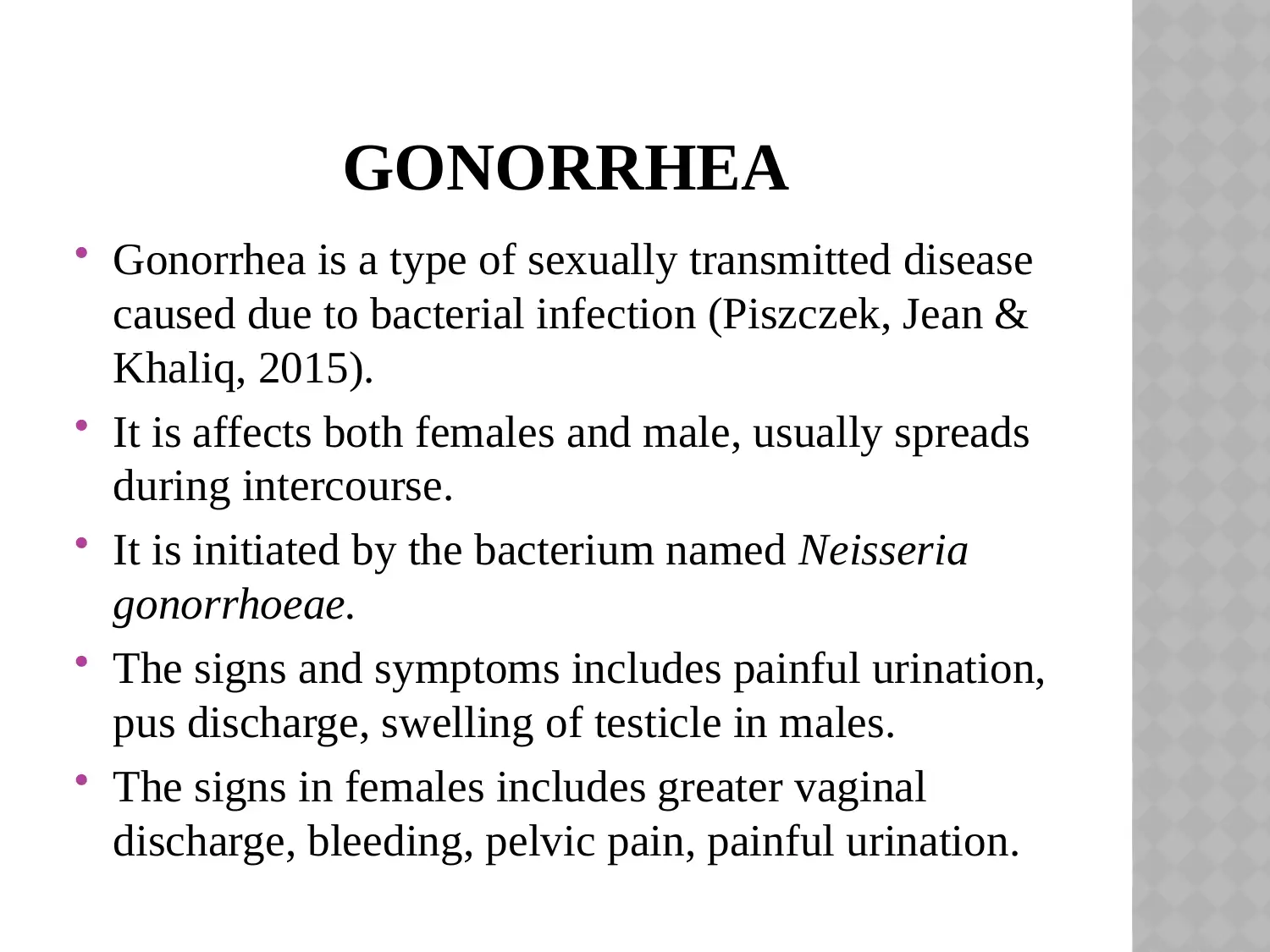
GONORRHEA
Gonorrhea is a type of sexually transmitted disease
caused due to bacterial infection (Piszczek, Jean &
Khaliq, 2015).
It is affects both females and male, usually spreads
during intercourse.
It is initiated by the bacterium named Neisseria
gonorrhoeae.
The signs and symptoms includes painful urination,
pus discharge, swelling of testicle in males.
The signs in females includes greater vaginal
discharge, bleeding, pelvic pain, painful urination.
Gonorrhea is a type of sexually transmitted disease
caused due to bacterial infection (Piszczek, Jean &
Khaliq, 2015).
It is affects both females and male, usually spreads
during intercourse.
It is initiated by the bacterium named Neisseria
gonorrhoeae.
The signs and symptoms includes painful urination,
pus discharge, swelling of testicle in males.
The signs in females includes greater vaginal
discharge, bleeding, pelvic pain, painful urination.

GONORRHEA
The disease has many complications such as
infertility in male and female, fever, swelling, joint
pain, sepsis and risk of human immunodeficiency
virus infection.
The disease can be diagnosed with the help of
laboratory testing of urine sample and swab testing
to identify the bacteria.
The condition can treated with antibiotics such as
ceftriaxone and azithromycin.
The disease has many complications such as
infertility in male and female, fever, swelling, joint
pain, sepsis and risk of human immunodeficiency
virus infection.
The disease can be diagnosed with the help of
laboratory testing of urine sample and swab testing
to identify the bacteria.
The condition can treated with antibiotics such as
ceftriaxone and azithromycin.
⊘ This is a preview!⊘
Do you want full access?
Subscribe today to unlock all pages.

Trusted by 1+ million students worldwide
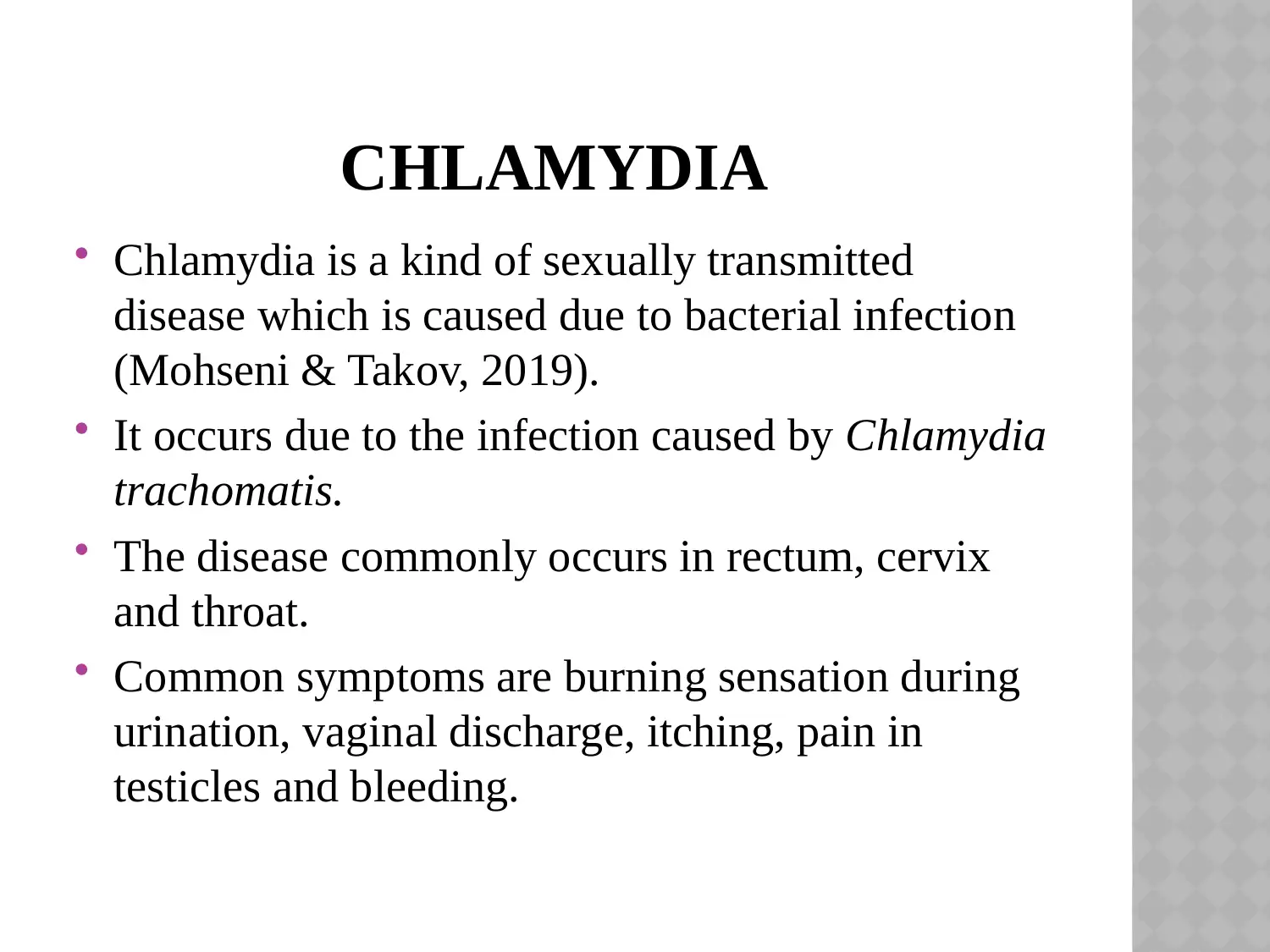
CHLAMYDIA
Chlamydia is a kind of sexually transmitted
disease which is caused due to bacterial infection
(Mohseni & Takov, 2019).
It occurs due to the infection caused by Chlamydia
trachomatis.
The disease commonly occurs in rectum, cervix
and throat.
Common symptoms are burning sensation during
urination, vaginal discharge, itching, pain in
testicles and bleeding.
Chlamydia is a kind of sexually transmitted
disease which is caused due to bacterial infection
(Mohseni & Takov, 2019).
It occurs due to the infection caused by Chlamydia
trachomatis.
The disease commonly occurs in rectum, cervix
and throat.
Common symptoms are burning sensation during
urination, vaginal discharge, itching, pain in
testicles and bleeding.
Paraphrase This Document
Need a fresh take? Get an instant paraphrase of this document with our AI Paraphraser
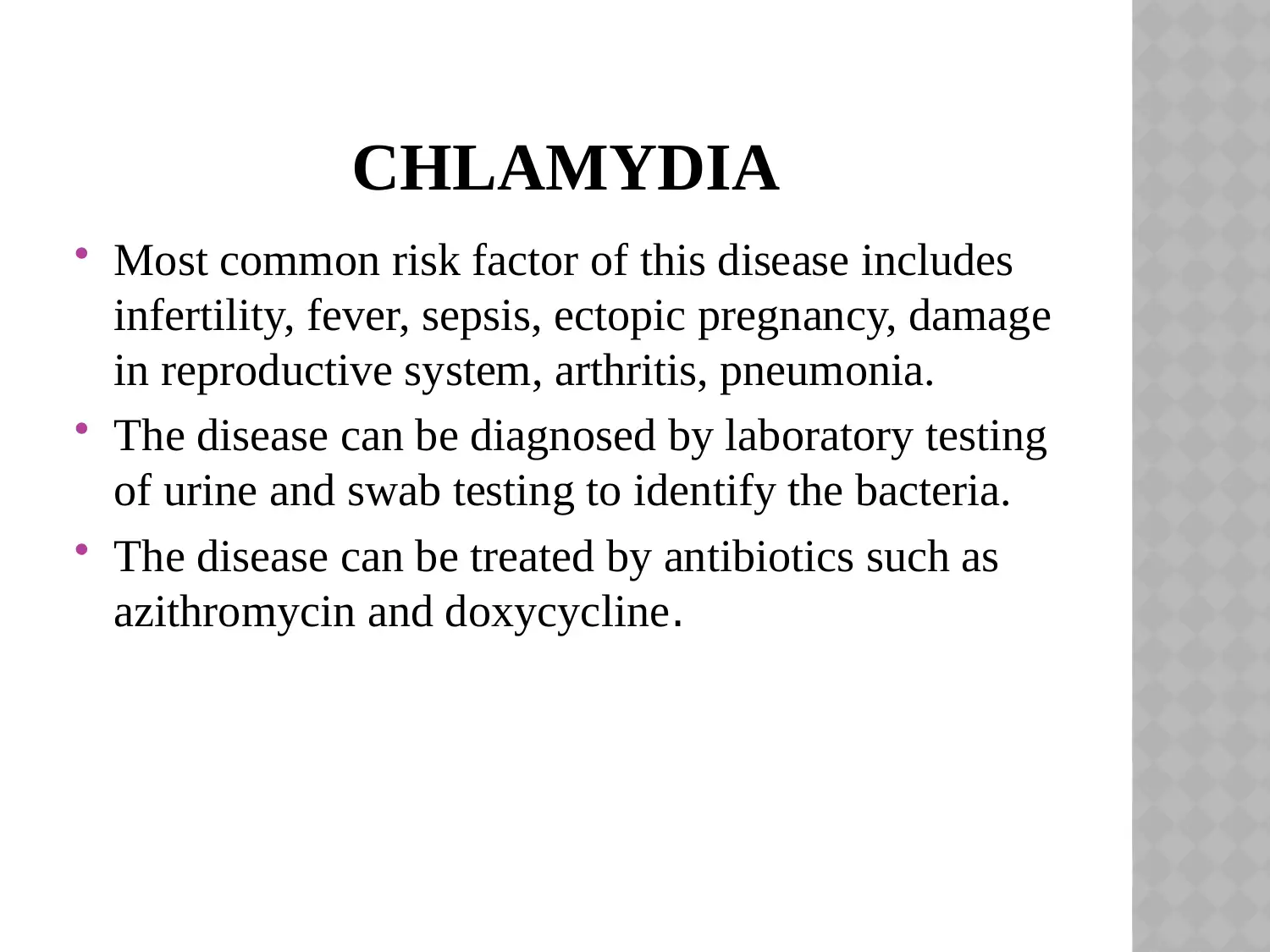
CHLAMYDIA
Most common risk factor of this disease includes
infertility, fever, sepsis, ectopic pregnancy, damage
in reproductive system, arthritis, pneumonia.
The disease can be diagnosed by laboratory testing
of urine and swab testing to identify the bacteria.
The disease can be treated by antibiotics such as
azithromycin and doxycycline.
Most common risk factor of this disease includes
infertility, fever, sepsis, ectopic pregnancy, damage
in reproductive system, arthritis, pneumonia.
The disease can be diagnosed by laboratory testing
of urine and swab testing to identify the bacteria.
The disease can be treated by antibiotics such as
azithromycin and doxycycline.
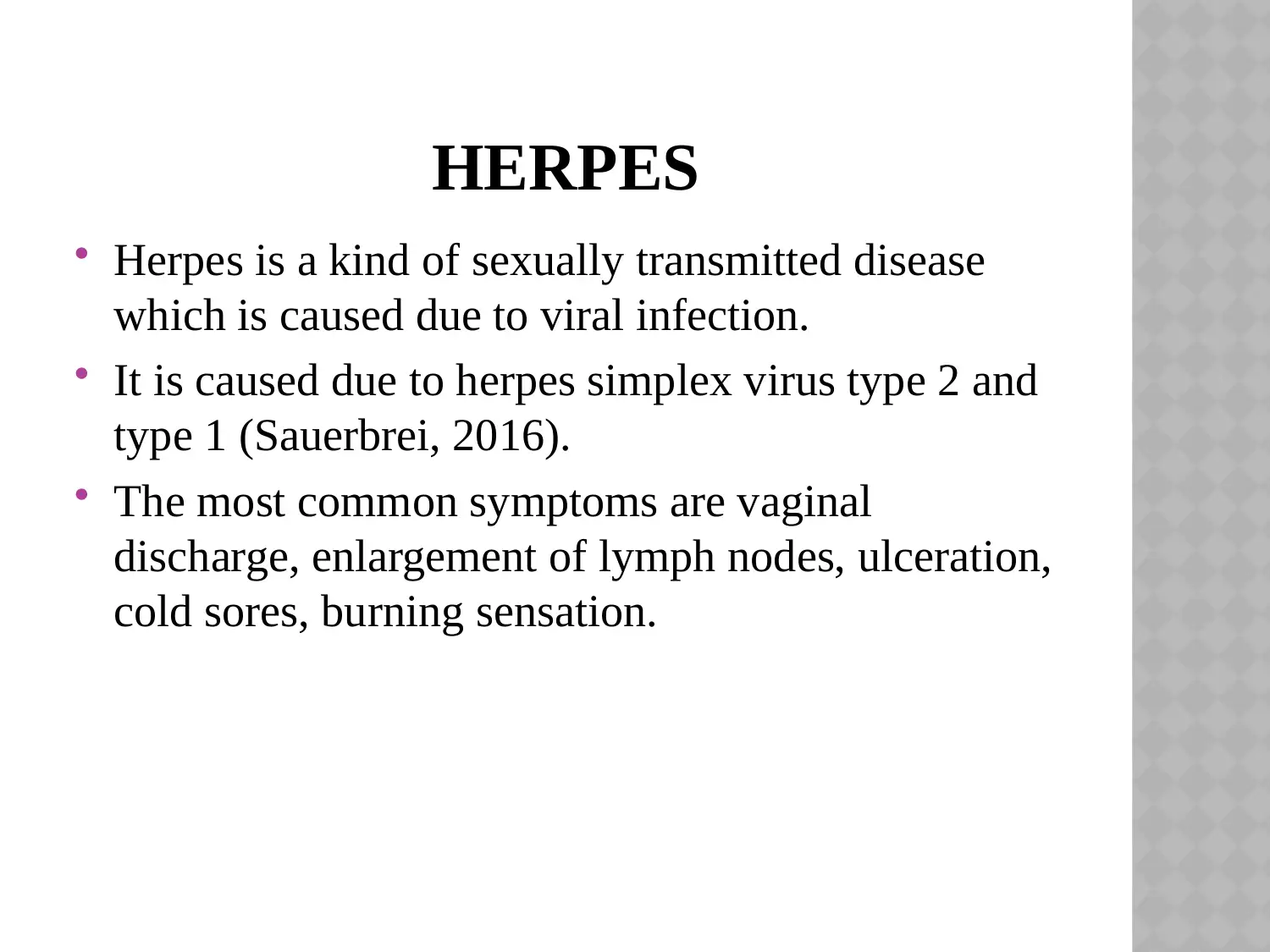
HERPES
Herpes is a kind of sexually transmitted disease
which is caused due to viral infection.
It is caused due to herpes simplex virus type 2 and
type 1 (Sauerbrei, 2016).
The most common symptoms are vaginal
discharge, enlargement of lymph nodes, ulceration,
cold sores, burning sensation.
Herpes is a kind of sexually transmitted disease
which is caused due to viral infection.
It is caused due to herpes simplex virus type 2 and
type 1 (Sauerbrei, 2016).
The most common symptoms are vaginal
discharge, enlargement of lymph nodes, ulceration,
cold sores, burning sensation.
⊘ This is a preview!⊘
Do you want full access?
Subscribe today to unlock all pages.

Trusted by 1+ million students worldwide
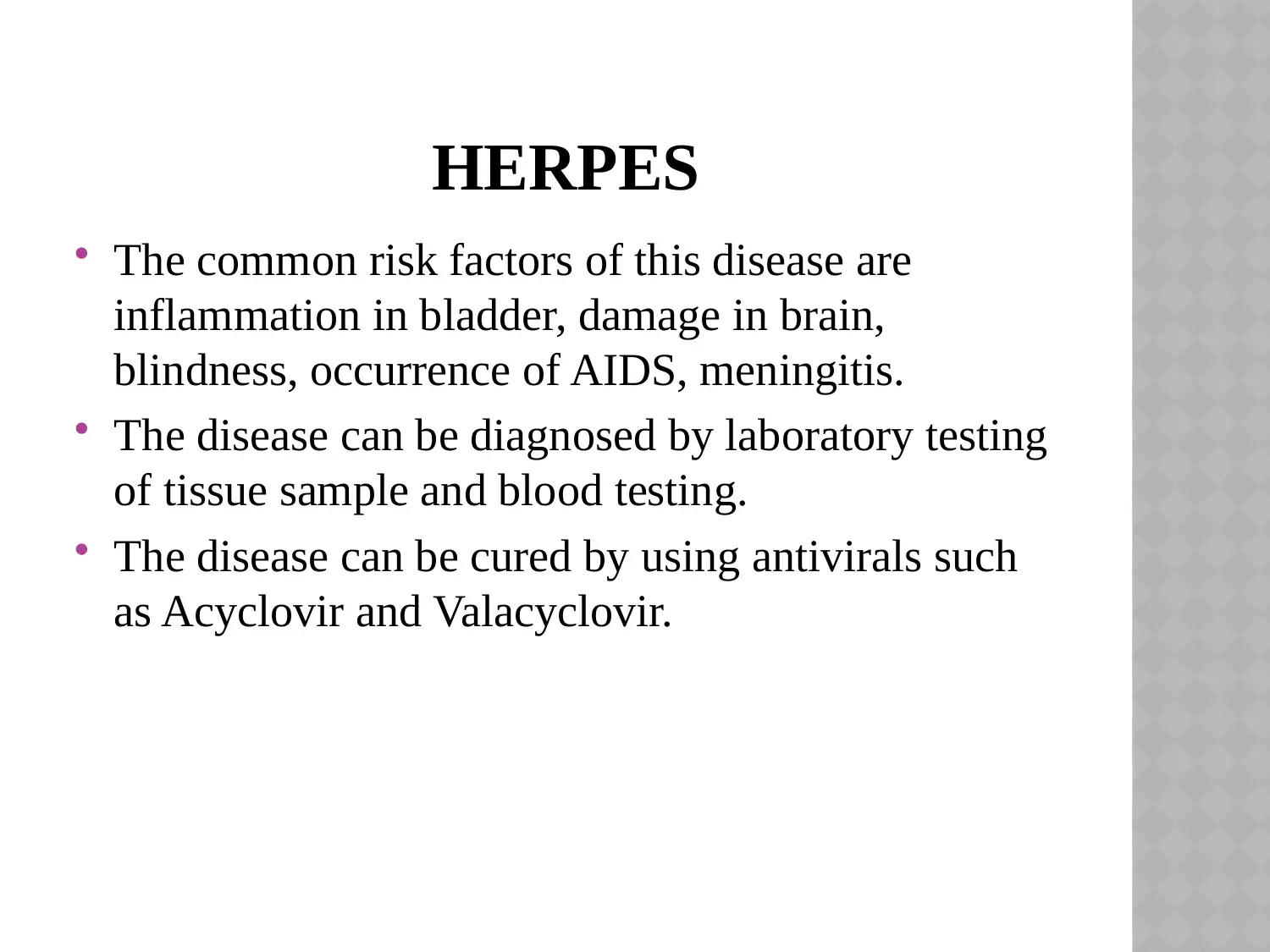
HERPES
The common risk factors of this disease are
inflammation in bladder, damage in brain,
blindness, occurrence of AIDS, meningitis.
The disease can be diagnosed by laboratory testing
of tissue sample and blood testing.
The disease can be cured by using antivirals such
as Acyclovir and Valacyclovir.
The common risk factors of this disease are
inflammation in bladder, damage in brain,
blindness, occurrence of AIDS, meningitis.
The disease can be diagnosed by laboratory testing
of tissue sample and blood testing.
The disease can be cured by using antivirals such
as Acyclovir and Valacyclovir.
Paraphrase This Document
Need a fresh take? Get an instant paraphrase of this document with our AI Paraphraser
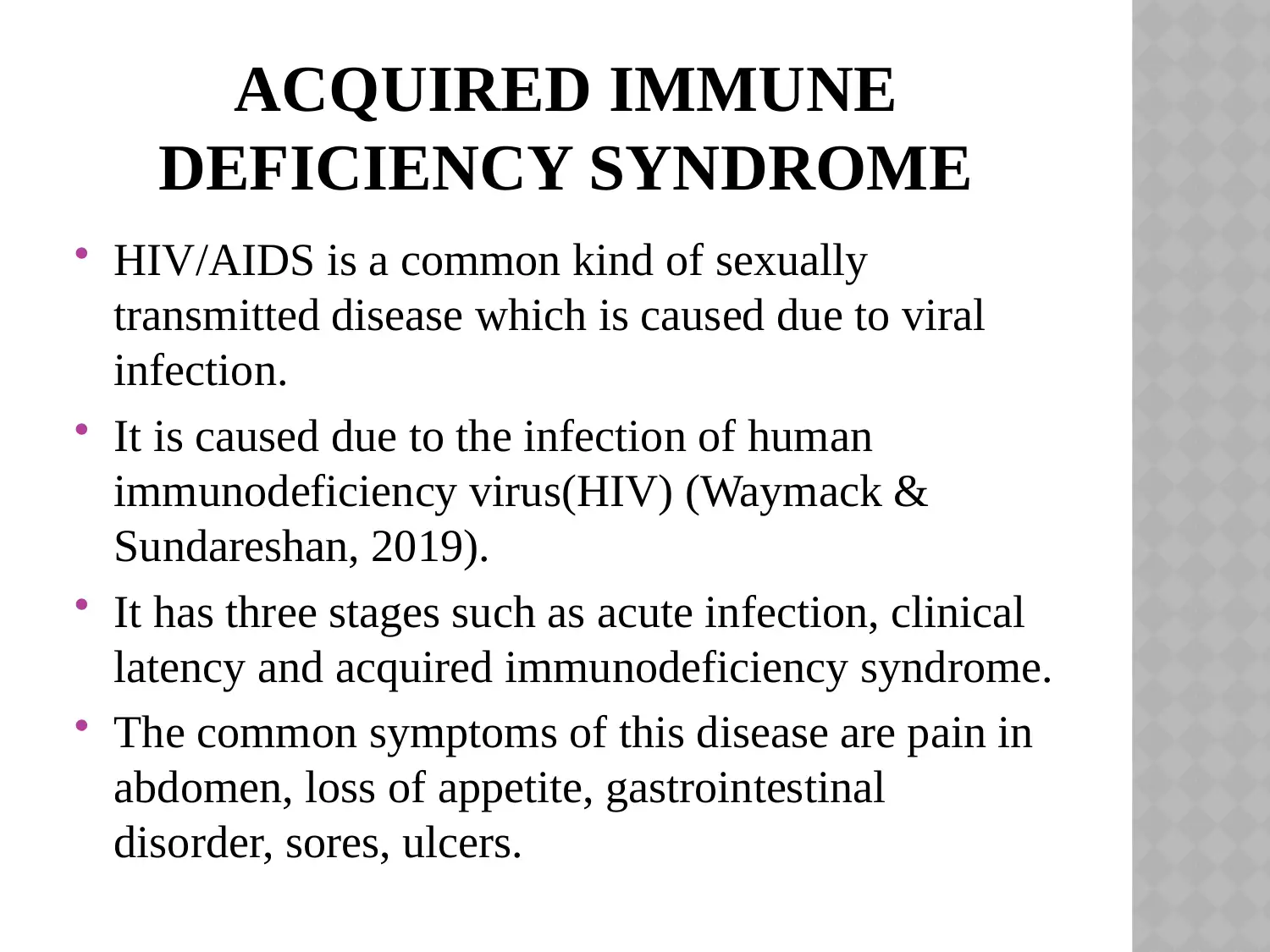
ACQUIRED IMMUNE
DEFICIENCY SYNDROME
HIV/AIDS is a common kind of sexually
transmitted disease which is caused due to viral
infection.
It is caused due to the infection of human
immunodeficiency virus(HIV) (Waymack &
Sundareshan, 2019).
It has three stages such as acute infection, clinical
latency and acquired immunodeficiency syndrome.
The common symptoms of this disease are pain in
abdomen, loss of appetite, gastrointestinal
disorder, sores, ulcers.
DEFICIENCY SYNDROME
HIV/AIDS is a common kind of sexually
transmitted disease which is caused due to viral
infection.
It is caused due to the infection of human
immunodeficiency virus(HIV) (Waymack &
Sundareshan, 2019).
It has three stages such as acute infection, clinical
latency and acquired immunodeficiency syndrome.
The common symptoms of this disease are pain in
abdomen, loss of appetite, gastrointestinal
disorder, sores, ulcers.

ACQUIRED IMMUNE
DEFICIENCY SYNDROME
There are many complication of this disease such
as pneumocystis pneumonia, candidiasis,
tuberculosis, toxoplasmosis, cytomegalovirus,
liver diseases, nerve damage, kidney diseases.
The disease can be diagnosed by enzyme-linked
immunosorbent assay and western blot.
There is no such treatment for this condition,
however, Abacavir, Retrovir can be used in the
treatment.
DEFICIENCY SYNDROME
There are many complication of this disease such
as pneumocystis pneumonia, candidiasis,
tuberculosis, toxoplasmosis, cytomegalovirus,
liver diseases, nerve damage, kidney diseases.
The disease can be diagnosed by enzyme-linked
immunosorbent assay and western blot.
There is no such treatment for this condition,
however, Abacavir, Retrovir can be used in the
treatment.
⊘ This is a preview!⊘
Do you want full access?
Subscribe today to unlock all pages.

Trusted by 1+ million students worldwide
1 out of 17
Related Documents
Your All-in-One AI-Powered Toolkit for Academic Success.
+13062052269
info@desklib.com
Available 24*7 on WhatsApp / Email
![[object Object]](/_next/static/media/star-bottom.7253800d.svg)
Unlock your academic potential
Copyright © 2020–2025 A2Z Services. All Rights Reserved. Developed and managed by ZUCOL.





